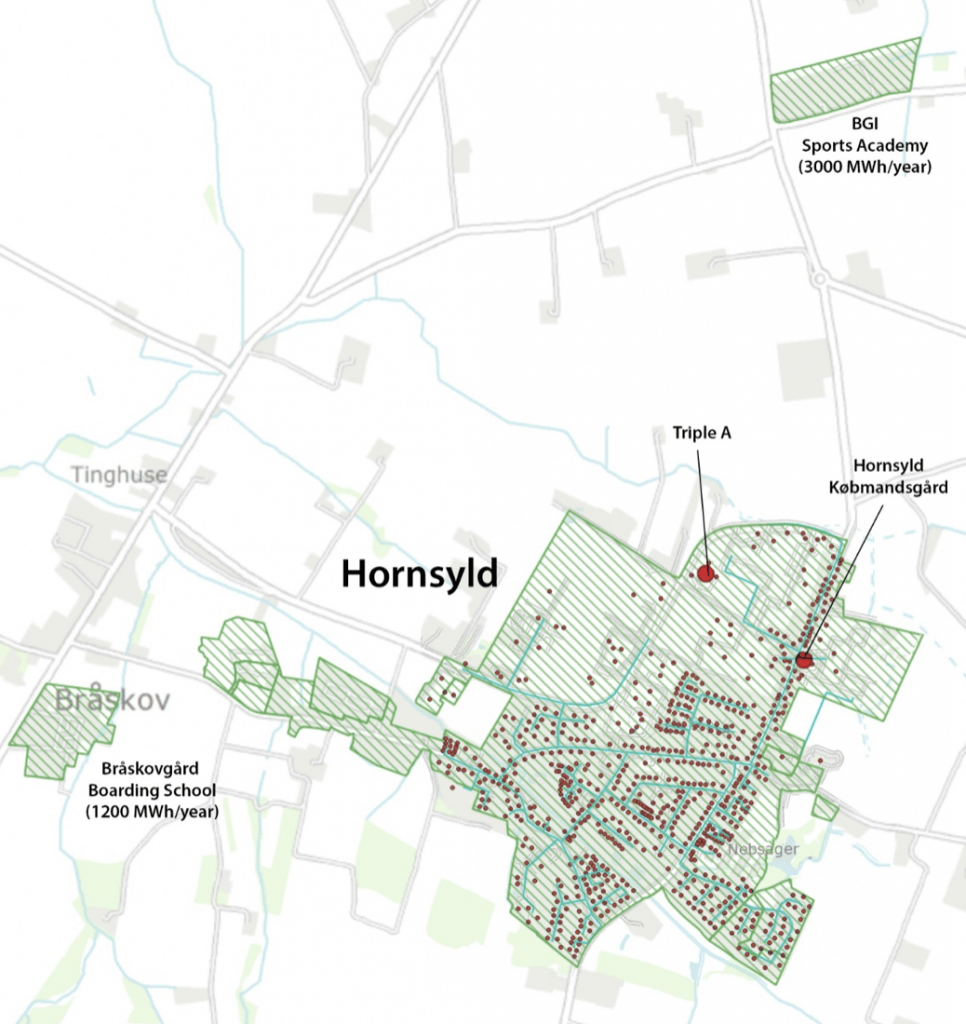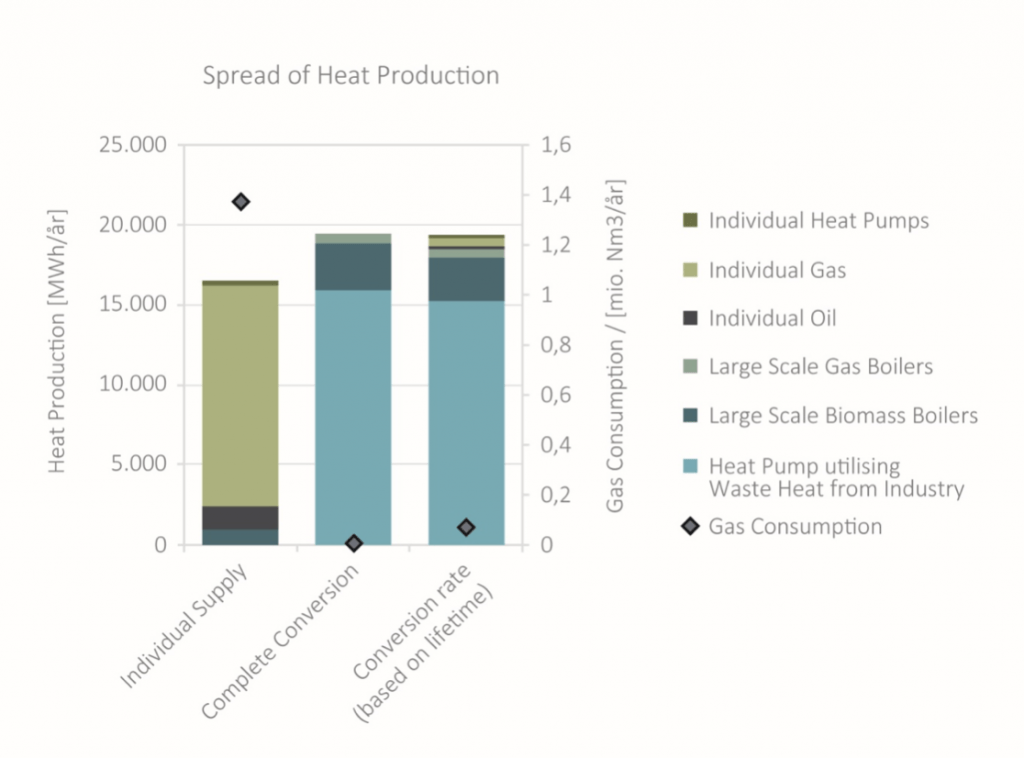Hornsyld is a compact town with a relatively high density of heat consuming buildings with a peak heat load of 5.3MW. Currently, most dwellings and businesses in Hornsyld are heated by individual natural gas boilers despite a large amount of waste heat being lost to atmosphere by the town’s industries.
In response, the local council is proposing to install a new district heating system to utilize the waste heat from industry.

Wasted Heat
The two main industries in the town are Triple A, an animal feed producer and Hornsyld Købmandsgård, a grocer and agro-business.
The waste heat for the scheme will comes from a feed dryer at Triple A. The drying process uses air heated directly by the combustion of natural gas. The heated air is drawn through the feed, which evaporates approximately 6000 litres of water an hour. Currently, the hot and humid exhaust air is discharged to atmosphere at a temperature of approximately 60℃.
Under the council’s proposal, a scrubber will be used to wash the exhaust air with cold water to condense the vapour from the air stream. A heat pump will be used to extract heat from the warmed condensate and then to raise its temperature to the outlet temperature for the district heating supply.
The process is expected to produce between 4 and 5 MW of heat. However, only 3MW will be utilised for this project, consisting of 2 MW supplied by the heat pump with an additional 1 MW from direct exchange. The feed dryer is expected to run for a minimum of 7500 hours per year. Heat production is calculated to give a system COP of 6.75.
Biomass Boiler
Two boilers at Hornsyld Købmandsgård will be used to supplement the reclaimed heat from Triple A.
One is a 1.8 MW unit fuelled by biomass, which is primarily waste material from grain products. The heat is primarily used for process heating for Triple A. When production is underway at Triple A, only 0.9MW of capacity will be available from the biomass boiler.
In addition, the boiler is used to produce heat for Hornsyld School, Hornsyld Købmandsgård and a few other nearby buildings, all of which are expected to be included in the district heating system, so this element of boiler capacity will be available to the network.
Gas Boiler
The other Hornsyld Købmandsgård boiler is a 4MW oil-fired boiler. This will be converted to run on natural gas under the project. This serves as a back-up to the biomass boiler. It has been been assumed that 3.5MW of capacity will be available for the district heating supply.
The operational and maintenance costs of both boilers will be covered under the scheme.

Thermal Store
According to the Danish Energy Agency’s forecast, biogas will in Denmark cover 72% of the gas consumption and green gas will completely replace natural gas in space heating by 2030. In 2020 biogas covered 21.2% at 170g CO2/kWh.
To provide a buffer between the heat demand, production at Triple A, and the operation of the boilers, the system will incorporate a 1000m3 thermal store. The addition of the storage tank will allow a higher utilization of the available waste heat and the biomass boiler.
Network
As there is currently no heat network in Hornsyld, a new plantroom will be constructed to serve a new district heating system. This will house pumps, controls and a monitoring system in addition to the heat pump and thermal store. Heat will be distributed via a pre-insulated twin-pipe system.
Anchor Loads
Of the 471 buildings supplied by natural gas in Hornsyld there are 29 large heat consumers with an annual heat demand of over 100 MWh, including public buildings, schools and sports facilities. Together they could amount to a heat demand of over 9,000 MWh annually, which will provide sufficient anchor loads for the heat network. The council hope that a high connection rate can be achieved by signing up these large consumers so that the project is less dependent on getting a high take-up from large numbers of domestic customers.
The heat network is dimensioned to supply 100% of Hornsyld’s heat demand. However, the project has assumed a total connection rate corresponding to 60% of the heating demand. The project is expected to be converted at the conversion rate indicated in the Table. In addition, a total annual heat loss of 15.2% has been calculated for the network, corresponding to 2,942 MWh/year, this gives a total heat requirement of 19,395 MWh/year.
| Year | 1 | 2 | 3 | 4 | 5 |
| Heating needs | 50% | 75% | 85% | 95% | 100% |
| Connecting cables and consumer installations | 50% | 75% | 85% | 95% | 100% |
| Main lines | 75% | 85% | 90% | 95% | 100% |
| Production plants and other | 100% |
Economic and Socio-Economic Benefits
The project is expected to provide an annual cost saving of 6300 DKK (about £700) for a typical dwelling currently heated by natural gas and an annual cost saving of 5400 DKK (about £600) for a typical dwelling heated by an air-to-water heat pump. The savings are well above the minimum set by the Danish Project Evaluation Act, which requires a cost saving of £170 per household for the project to be approved.
From the socio-economic impact calculations, an estimated socio-economic surplus of £4.1 million has been identified for the project over a period of 20 years, largely due to the reduction in natural gas consumption which more than offsets the investment cost of the project.

